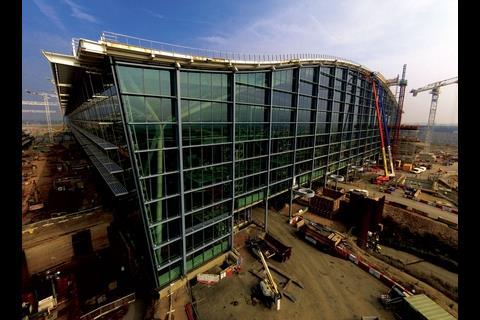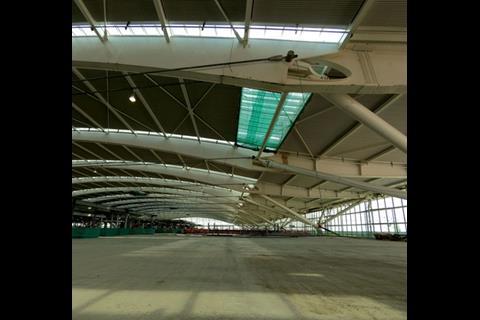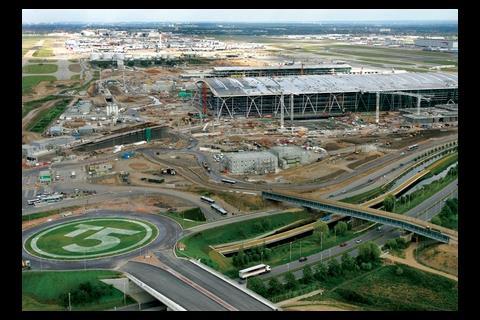BAA used Terminal 5 to test-fly a number of exciting, but highly experimental practices. As Thomas Lane discovers, they all took off â then suffered very different fates
To understand why Heathrow Terminal 5 was such an important project, we have to begin with a brief history lesson.
When BAA was planning the ÂŁ4.3bn scheme at the beginning of the present decade, the construction industry was, to put it mildly, in a state of flux. Its performance over the nineties had been so poor that Conservative and Labour governments had held full-scale reviews and passed primary legislation to try to improve it. Large civil engineering projects, such as the Channel Tunnel and the Jubilee Line Extension (JLE) had been crippled by labour disputes and ended up with huge cost and time overruns. And throughout the industry, project teams seemed to spend as much time grappling with each other as the job in hand. Money, trust and co-operation were in short supply; paranoia was free to everyone.
T5 was so important to BAA that it was willing, in effect, to create an entirely new industry to build it, freed of all the knuckle-headed practices that had grown like ivy around the old one. So, where traditional projects ended up with the client suing the contractor suing the engineer suing the groundworks subbie, BAA wanted to create a no blame culture. To do that it originated the âT5 Agreementâ, by which it would bear all the financial risk and its suppliers would work in integrated teams without living in fear of friendly fire.
And where traditional projects struggled to integrate the teamâs different technical languages, drawings and IT formats, T5 would have a single CAD building model, a kind of virtual paradise in which the engineer lay down with the architect, the QS knew the price and the value of everything, and the services engineer couldnât make a mistake if it tried.
The war of industrial attrition that had pushed the JLE to the edge of calamity was to be avoided by stuffing the pockets of the workers with gold. The going rate for a skilled tradesperson who fulfilled all their productivity requirements was to be ÂŁ55,000. Whatâs more, they were to be afforded the best of site services, including comprehensive preventative medical care.
The result was that BAA got its terminal on time and within budget. That in itself would appear to be a vindication of its methods. But T5 was supposed to do more than that. The little industry that BAA made was supposed to flow out into the larger one, and eventually replace it. T5, according to Peter Rogers, then chairman of the Strategic Forum, was to be âa template for the future of constructionâ.
To put it another way: was the project a kind of mink coat, the work of a super-sophisticated client for which money was no object but with no real relevance to the grubby donkey jacket world of the standard site?
Below we look at some of the key ideas that were used at T5, see whether they were successful and look at the impact on the wider industry.
The T5 agreement
What is it?
This was the headline innovation at T5. It was used because BAA considered it essential to delivering a project of this size on time and budget. The reasoning was that no single contractor could be expected to bear ÂŁ4.3bn of risk, and even if it did it would create too much tension within the project. So BAA bore all the financial risk and in return the project team put their company allegiances to one side and moved into the same offices. But BAA still had to work hard to ensure the experiment succeeded. It put together a huge in-house team to supervise and control the integrated project team, and therefore the risk it had taken on.
How successful was it at T5?
The project was delivered on time and on budget so it did what it set out to do. But it went beyond that. The people involved say it was fundamental to solving many of the challenges of the project. âForcing people to co-locate meant they worked together and made people really understand and appreciate the technical challenges,â says structural engineer Dervilla Mitchell, Arupâs head of design management on T5. She says this helped to deliver the terminalâs huge roof and its control tower.
What impact has it had on the wider industry?
None. Its use at T5 is the only case in which a client has carried out such an arrangement. âItâs aimed at megaprojects and there are a limited number of these, and all have their reasons for not using it,â says Don Ward, chief executive of Constructing Excellence. âMost clients donât have that insight into risk, and they donât have the ability to manage it. Plus they donât have deep enough pockets.â
Even BAA may not use it again. It plans to make up to 200 of its construction projects division staff redundant and said it would not necessarily be using the T5 agreement on all its future projects, including T5âs baby brother T5c. Ward does say a similar form of procurement could be used on nuclear power stations. Another distant possibility is the Olympics, although Howard Shiplee, the construction director for the Games, has indicated this is not going to happen.
Major projects agreement
What is it?
This was launched in December 2003 by Amicus and the M&E trade bodies in an effort to avoid the strife witnessed on the Channel Tunnel and the JLE. The carrot was pay of up to ÂŁ55,000 a year for M&E site workers in return for increased productivity.
How successful was it at T5?
An independent report prepared by cost consultant Baker Mallett in August 2005 found that 88% of people involved with the project thought productivity had improved and industrial relations were âvery goodâ. Unfortunately, some of the shine was dulled by reports that BAA had exceeded its M&E budget by 50%, adding another ÂŁ90m to the final bill. BAA blamed changes to the scope of works for this, rather than low productivity. There have also been several threatened strikes by steelworkers and electricians, but these have mostly been averted.
What impact has it had on the wider industry? Not much so far. As with the T5 agreement, the Olympic Delivery Authority (ODA) has been making noises about using it. Although no decision has been made, the vibe coming out of the ODA is that it is too expensive.
Single project model
What is it?
The idea was to get everyone to share a single CAD model when designing the terminal. This meant that each member of the team did not have to draw its own building. The second advantage was that everyone worked from the same set of data, thereby eliminating design clashes before the project got to site. Finally, this data could be used by the facilities management teams. An earlier BAA pilot project had proved that this approach could save up to 10% of the project cost.
The difficulty is educating people on how to use the software and educating clients about the savings that can be made. Thereâs still a long way to go
Mervyn Richards, CAD manager
How successful was it at T5?
Mervyn Richards, Laing OâRourkeâs CAD manager at the time, describes it as âvery successfulâ. He says it is hard to be exact about how much money was saved, but 5% of the project cost is the figure quoted by BAA. That is the trifling sum of ÂŁ210m.
What impact has it had on the wider industry? Richards has since left Laing OâRourke and has been actively trying to promote the benefits of this type of collaborative working. The first stage was getting funding from the old DTI for a project called Avanti. This took the T5 principles and applied them to a series of more workaday projects. According to Richards this saved 10% of project costs for participating firms. Despite that, the availability of a British Standards code of practice and ever more sophisticated software, there is still a lot to do. Richards says: âThe difficulty is educating people on how to use the software and educating clients about the savings that can be made. Thereâs still a long way to go âŠâ
Single project insurance
What is it?
Instead of every consultant and contractor having its own insurance policy, BAA took out a single policy that covered everyone. The theory was that one big umbrella was cheaper to erect than hundreds of little ones â and offered far less scope for legal problems.
How successful was it at T5?
BAA could afford to pay for cock-ups, so it has not been tested in a meaningful way.
What impact has it had on the wider industry? Single project insurance has been talked about for years but only now are there signs that things are beginning to change. It is being piloted on a healthcare project in Southport, Cheshire, and according to Constructing Excellenceâs Ward there are likely to be another half dozen pilots. He says it takes a long time for this type of innovation to filter through. Another problem is getting an overall reduction in premiums. âThe biggest single barrier is that you have to persuade the insurers to reduce the premiums of the individual companies involved.â
Smart logistics
What are they?
BAA recognised that the scale and speed of construction at T5 meant getting materials to the right people at the right time was crucial to the projectâs schedule. Part of that job fell to site services company Wilson James. Gary Sullivan, its managing director, comments: âAt T5, Tony Douglas [the managing director of T5] and Andrew Wolstenholme [its construction director], said logistics were so important that if we didnât put it first we wouldnât get it finished on time. They planned it as a logistics operation first rather than as a construction project with logistics bolted on, which was a change of emphasis.â
The first thing to do was to set up a logistics centre. During the early stages of the project this was used as a factory to make reinforcement cages, then it was used as a control point for vehicles carrying goods directly onto site. During the fit-out stage it was used as a consolidation centre. At this stage different components would be consolidated into one package, for example plasterboard with its associated studwork, and delivered to the parts of the site where it was needed.
How successful were they at T5?
Full marks.
What impact have they had on the industry? âWhat T5 did was change the standing of logistics,â says Sullivan. âItâs given it a much higher profile and more contractors are paying more attention to it, although not as much as I would like.â He adds that the London Consolidation Centre was a direct result of T5. This is a centre in south-east London that supplies contractors in the capital. Part of its funding has come from Transport to London which sees consolidation centres as a way of reducing congestion. Figures for traffic reduction are impressive, but contractors have still not been convinced that it is worth using â the centre is still not self-financing. It has recently moved to a site in Silvertown, east London, in the hope of getting business from the Olympics and the Thames Gateway.
Innovative construction techniques
What are they?
A number of techniques were used at T5 to speed up construction. Most were not new, although T5 aimed to optimise them. For example BAA wanted to improve productivity by 10-15% using off-site construction. As well as the prefabricate reinforcement cages already mentioned, the roof sections were made on the ground and jacked into position, which was a technique borrowed from bridge building.
BAA wanted to carry out dry runs, or, in the jargon, âfirst run studiesâ of operations that could affect the critical path.
How successful were they at T5?
By and large these techniques helped the project. For example, dry runs on the roof saved âin excess of 100 days, which was about ÂŁ2.8mâ, according to Bill Frankland, head of the T5 roofing team at Laing OâRourke. Arupâs Mitchell describes the prefabricated reinforcement as âa great storyâ. On the other hand she doesnât think prefabrication always worked. âI think it helped in some areas but hindered in others.â The reason being that airport terminals need to be designed as late as possible to accommodate the changing needs of the airline industry, so in some areas the design was done first, then adapted for prefabrication.
What impact have they had on the industry?
A mixed bag. Prefabrication is slowly gaining ground, particularly in M&E â at T5, prefabricated service âchimneysâ were one of the biggest ever prefabrication projects. Frankland is not aware of any other projects that have used first-run studies to the same extent as T5. He says the roof jacking procedure was really dictated by the constraints of the project â its complexity and scale and the requirement of working under a radar ceiling. Roof jacking has been used since, notably for the roof of the O2 arena, but this method was used because the roof was being constructed inside an existing structure.
Postscript
For a comprehensive history of T5, search































1 Readers' comment